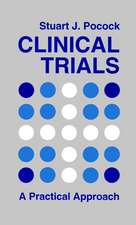Cell Surface Receptors: A Short Course on Theory and Methods
Autor Lee E. Limbirden Limba Engleză Paperback – 21 mar 2013
| Toate formatele și edițiile | Preț | Express |
|---|---|---|
| Paperback (3) | 364.33 lei 6-8 săpt. | |
| Springer Us – 21 mar 2013 | 364.33 lei 6-8 săpt. | |
| Springer Us – 28 oct 2010 | 1090.77 lei 6-8 săpt. | |
| Springer Us – 13 dec 2011 | 1092.22 lei 6-8 săpt. | |
| Hardback (2) | 1096.98 lei 6-8 săpt. | |
| Springer Us – 30 dec 1995 | 1096.98 lei 6-8 săpt. | |
| Springer Us – 11 noi 2004 | 1098.12 lei 6-8 săpt. |
Preț: 364.33 lei
Preț vechi: 383.50 lei
-5% Nou
Puncte Express: 546
Preț estimativ în valută:
69.72€ • 74.55$ • 58.13£
69.72€ • 74.55$ • 58.13£
Carte tipărită la comandă
Livrare economică 18 aprilie-02 mai
Preluare comenzi: 021 569.72.76
Specificații
ISBN-13: 9781475718843
ISBN-10: 1475718845
Pagini: 216
Ilustrații: XV, 196 p. 8 illus.
Dimensiuni: 155 x 235 x 11 mm
Greutate: 0.31 kg
Ediția:1986
Editura: Springer Us
Colecția Springer
Locul publicării:New York, NY, United States
ISBN-10: 1475718845
Pagini: 216
Ilustrații: XV, 196 p. 8 illus.
Dimensiuni: 155 x 235 x 11 mm
Greutate: 0.31 kg
Ediția:1986
Editura: Springer Us
Colecția Springer
Locul publicării:New York, NY, United States
Public țintă
ResearchCuprins
1 Historical perspective.- 2 Methods for characterization of receptors based on receptor-mediated responses in tissue or intact cell preparations.- 3 Identification of receptors using direct radioligand binding techniques.- 4 Complex binding phenomena.- 5 The preparation and study of detergent-solubilized receptors.- 6 Biochemical correlates of the topographical fate of ligand-receptor complexes.- Inde.
Descriere
Descriere de la o altă ediție sau format:
Cell Surface Receptors: A Short Course on Theory and Methods, 3rd Edition, links theoretical insights into drug-receptor interactions described in mathematical models with the experimental strategies to characterize the biological receptor of interest. The study of receptors has changed considerably over the period of the publication of the three editions of this book. The cloning of several genomes makes it unlikely that preparations of receptors now or in the future will arise from their purification as trace proteins from native tissues, but rather from a myriad of molecular approaches. Nonetheless, understanding the molecular mechanisms and ultimately the in vivo biology of these receptors means that investigators will engage in molecular, cellular and ultimate in vivo strategies. It should be of value to investigators who want to identify, characterize and understand the biology of a receptor of interest.
Cell Surface Receptors: A Short Course on Theory and Methods, 3rd Edition, links theoretical insights into drug-receptor interactions described in mathematical models with the experimental strategies to characterize the biological receptor of interest. The study of receptors has changed considerably over the period of the publication of the three editions of this book. The cloning of several genomes makes it unlikely that preparations of receptors now or in the future will arise from their purification as trace proteins from native tissues, but rather from a myriad of molecular approaches. Nonetheless, understanding the molecular mechanisms and ultimately the in vivo biology of these receptors means that investigators will engage in molecular, cellular and ultimate in vivo strategies. It should be of value to investigators who want to identify, characterize and understand the biology of a receptor of interest.
Textul de pe ultima copertă
Cell Surface Receptors: A Short Course on Theory and Methods, 3rd Edition, links theoretical insights into drug-receptor interactions described in mathematical models with the experimental strategies to characterize the biological receptor of interest. The study of receptors has changed considerably over the period of the publication of the three editions of this book. The cloning of several genomes makes it unlikely that preparations of receptors now or in the future will arise from their purification as trace proteins from native tissues, but rather from a myriad of molecular approaches. Nonetheless, understanding the molecular mechanisms and ultimately the in vivo biology of these receptors means that investigators will engage in molecular, cellular and ultimate in vivo strategies. It should be of value to investigators who want to identify, characterize and understand the biology of a receptor of interest.
This book is primarily targeted to researchers and graduate students in the fields of molecular pharmacology, receptors, receptor biology, and signal transduction. These courses are variously found in pharmacology, molecular and cell biology, biochemistry and neuroscience. Researchers in the pharmaceutical industry working on bringing new drugs to market will also find this book useful.
This book is primarily targeted to researchers and graduate students in the fields of molecular pharmacology, receptors, receptor biology, and signal transduction. These courses are variously found in pharmacology, molecular and cell biology, biochemistry and neuroscience. Researchers in the pharmaceutical industry working on bringing new drugs to market will also find this book useful.
Caracteristici
The advantage of this book is that it is a primer, and it is based upon the first three laws of thermodynamics.
The material is presented in a logical sequence that allows the researcher or student to understand methods and principles of cell surface receptors in a brief, focused manner
Includes supplementary material: sn.pub/extras
The material is presented in a logical sequence that allows the researcher or student to understand methods and principles of cell surface receptors in a brief, focused manner
Includes supplementary material: sn.pub/extras










